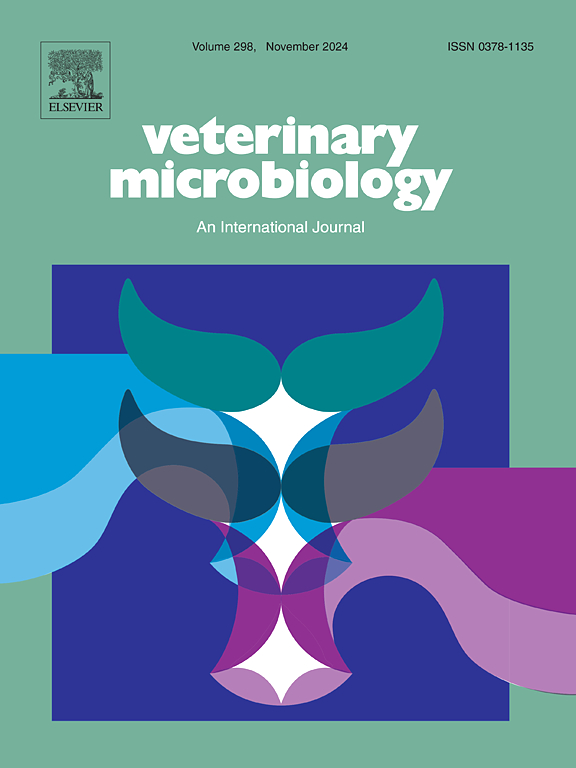首次在巴西自然感染的母狗中发现犬埃利希体垂直传播的分子证据
IF 2.7
2区 农林科学
Q3 MICROBIOLOGY
引用次数: 0
摘要
犬埃利希体是一种专性细胞内细菌,由血鼻头蜱传播。这种病原体也是犬单核细胞埃利希体病的病原,这是一种全球广泛分布的疾病,具有公认的人畜共患潜力。虽然病媒传播已得到充分证实,但支持发生垂直传播的证据仍然有限。本研究旨在通过分子诊断技术、基因测序和系统发育分析,探讨51只自然感染犬E.犬的经胎盘传播可能性。分析了51只母鼠的血液和胎盘样本,22只死产幼犬的器官池样本,以及40只5天大的新生儿的外周血。采用针对16S rRNA基因的巢式PCR进行分子分析,初步检测埃利希体属,随后特异性确认犬伊氏体,然后对阳性样本进行基因测序和系统发育鉴定。在27.45% %的母鼠血液样本、5.88 %的胎盘样本、9.09 %的死胎器官样本和2.5 %的5天大的活产幼犬样本中检测到埃利希氏体DNA。所获得的序列与先前鉴定的来自不同地理区域的犬伊原体分离株的同源性为100% %。该研究证实犬中存在经胎盘传播的犬E. canis,并强调了这一途径在维持和传播人畜共患病媒传播媒介方面的潜力。它强调需要研究病原体的垂直传播机制及其在流行地区的影响,并将生殖监测与犬类传染病控制相结合,以改善动物和公众健康。本文章由计算机程序翻译,如有差异,请以英文原文为准。
First molecular evidence of vertical transmission of Ehrlichia canis in naturally infected female dogs in Brazil
Ehrlichia canis is an obligate intracellular bacterium transmitted by the tick Rhipicephalus sanguineus sensu lato. This pathogen is also the etiological agent of canine monocytic ehrlichiosis, a disease with widespread global distribution and recognized zoonotic potential. Although vector-borne transmission is well established, evidence supporting the occurrence of vertical transmission remains limited. This study aimed to investigate the potential transplacental transmission of E. canis in 51 naturally infected pregnant bitches using molecular diagnostic techniques, genetic sequencing, and phylogenetic analysis. Blood and placental samples from the 51 dams, organ pool samples from 22 stillborn puppies, and peripheral blood from 40 live neonates up to five days of age were analyzed. Molecular analyses were performed using nested PCR targeting the 16S rRNA gene, with initial detection of the genus Ehrlichia and subsequent specific confirmation of E. canis, followed by genetic sequencing and phylogenetic characterization of the positive samples. Ehrlichia spp. DNA was detected in 27.45 % of dams blood samples, 5.88 % of placentas, 9.09 % of stillborns organ pools, and 2.5 % of live-born puppies up to five days old. The sequences obtained showed 100 % identity with previously characterized E. canis isolates from different geographic regions. The study confirms the occurrence of transplacental transmission of E. canis in dogs and highlights the potential of this route in the maintenance and dissemination of zoonotic vector-borne agents. It emphasizes the need to study vertical transmission mechanisms of pathogens and their impact in endemic areas, and to combine reproductive monitoring with infectious disease control in dogs for improved animal and public health.
求助全文
通过发布文献求助,成功后即可免费获取论文全文。
去求助
来源期刊

Veterinary microbiology
农林科学-兽医学
CiteScore
5.90
自引率
6.10%
发文量
221
审稿时长
52 days
期刊介绍:
Veterinary Microbiology is concerned with microbial (bacterial, fungal, viral) diseases of domesticated vertebrate animals (livestock, companion animals, fur-bearing animals, game, poultry, fish) that supply food, other useful products or companionship. In addition, Microbial diseases of wild animals living in captivity, or as members of the feral fauna will also be considered if the infections are of interest because of their interrelation with humans (zoonoses) and/or domestic animals. Studies of antimicrobial resistance are also included, provided that the results represent a substantial advance in knowledge. Authors are strongly encouraged to read - prior to submission - the Editorials (''Scope or cope'' and ''Scope or cope II'') published previously in the journal. The Editors reserve the right to suggest submission to another journal for those papers which they feel would be more appropriate for consideration by that journal.
Original research papers of high quality and novelty on aspects of control, host response, molecular biology, pathogenesis, prevention, and treatment of microbial diseases of animals are published. Papers dealing primarily with immunology, epidemiology, molecular biology and antiviral or microbial agents will only be considered if they demonstrate a clear impact on a disease. Papers focusing solely on diagnostic techniques (such as another PCR protocol or ELISA) will not be published - focus should be on a microorganism and not on a particular technique. Papers only reporting microbial sequences, transcriptomics data, or proteomics data will not be considered unless the results represent a substantial advance in knowledge.
Drug trial papers will be considered if they have general application or significance. Papers on the identification of microorganisms will also be considered, but detailed taxonomic studies do not fall within the scope of the journal. Case reports will not be published, unless they have general application or contain novel aspects. Papers of geographically limited interest, which repeat what had been established elsewhere will not be considered. The readership of the journal is global.
 求助内容:
求助内容: 应助结果提醒方式:
应助结果提醒方式:


